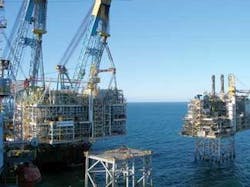Buzzard revives big-time production in central North Sea fairway
Potential second hub for Canadian newcomer Nexen
Jeremy Beckman, Editor, Europe
UK oil and gas production will veer upwards temporarily next year, thanks largely to input from Buzzard in the Outer Moray Firth. Buzzard is the UK’s largest new discovery of the past 10 years, and the £1.5 billion development project is the widest in scope since BP’s Clair, earlier this decade.
Operator Nexen expects to bring the field onstream by end-2006. Oil production should build rapidly to a plateau of 190-200,000 b/d in 2007. This should help lift output across the UK shelf to 3.5 MMboe/d, according to new figures from the UK Offshore Operators Association.
Nexen has wider-ranging plans to raise production from its relatively new UK base. These include development of Ettrick, a 39 MMbbl field northeast of Buzzard, via a newly converted FPSO. Farther east, in the main Central North Sea production corridor, the company is turning the Scott platform complex increasingly into a hub for new subsea tieback projects.
The company, formerly known as Canadian Occidental Petroleum, acquired operatorship of all three fields in December 2004, following a $2.1 billion transaction with EnCana. That package comprised EnCana’s entire UK North Sea exploration and production spread, including 43.2% of Buzzard, and 41% of Scott and 54.3% of Telford. There were also numerous undeveloped discoveries and interests in various exploration licenses covering a total of 740,000 net acres.
On closing the deal, Nexen’s President Charlie Fischer commented: “This is the most attractive suite of assets I’ve seen available for purchase in quite some time...with significant upside potential.” The associated risk could also have been a downside, but subsequent oil prices have vindicated the investment.
The transaction also brought Nexen much of the management team behind both the discovery and development of Buzzard, and the gradual takeover and rehabilitation of Scott since 2003, when the company first acquired operatorship of this ongoing development. Nexen has also retained the core of the Scott operations and management teams established by original operator, Amerada Hess.
Nexen Petroleum UK’s current managing director, based in London, is Phil Oldham, formerly North Sea operations director at EnCana. “EnCana was a seller and Nexen a buyer,” he points out, “so you would expect their respective strategies to be different. Nexen is very much focused on UKCS growth, and building on its assets. Those assets provide a very substantial operating and exploration base, with upside in all cases.
“Nexen’s intention was to grow from that base, via all the usual methods. Firstly, by fully optimizing Scott and taking on associated opportunities; then developing Buzzard; and finally, bringing forward Ettrick and other smaller satellite prospects. When we took over from EnCana, we had forward plans to drill 25-30 exploration wells. Currently, we’re drilling four to six exploratory wells per year, and we have also established an active business development team to pursue new opportunities.”
Delineating Buzzard
Buzzard is a large oilfield, with small quantities of associated gas, which extends across four UK blocks in the South Halibut Basin of the Outer Moray Firth. Two of the blocks - 20/6 and 19/10- were awarded to a group led by PanCanadian Petroleum in 1998 under the UK’s 18th offshore licensing round. PanCanadian acquired the other two -19/5 and 20/1 - a year later from BP, following its merger with Amoco.
According to Oldham, Amoco had pursued conventional exploration targets on these 16th Round blocks. PanCanadian, however, spotted potential in the datasets for stratigraphic traps, that hunch being proven in April 2001. The first exploratory well on the prospective Buzzard structure, drilled on block 20/6, encountered a 360-ft light oil column. An immediate sidetrack had similar good results, indicating reserves in that part of the structure of over 200 MMbbl.
Co-licensee BG Group managed the drilling program in those early stages, as PanCanadian was not a licensed drilling operator on the UK shelf. That situation changed when appraisal drilling started late in 2001. The following year, the company merged with Alberta Energy to form EnCana. By June 2002, EnCana and its partners had drilled six appraisal wells and two further sidetracks, using two semisubmersible rigs, at times simultaneously.
“That program was very successful,” Oldham says. “It allowed us to delineate the reservoir, firm up the oil/water contact, and evaluate injectivity potential.” The work program included a production test of three oil zones and one water production/injection test.
Later, the Western Geco vesselTopaz conducted a 305-sq km 3-D seismic survey over the entire Buzzard area. Interpretation of this data, allied to the drilling results, suggested in place reserves of 1.2 Bbbl, with over 550 MMbbl recoverable. “This was better than what we had expected,” Oldham claims.
The partners were united in pushing development through as quickly as possible. Late in 2002, Genesis Oil and Gas and John Brown Hydrocarbons in London were contracted respectively for concept screening and definition studies. After ruling out various proposals, including floating production and subsea-shore processing, the partners opted for a conventional, fixed platform solution. Their plan was approved by the UK government in November 2003.
Before Nexen assumed control of the project in 2004, Petro-Canada had farmed in, through buying Intrepid Energy. The current equity interests are Nexen Petroleum UK, 43.2%; Petro-Canada UK, 29.9%; BG Group, 21.7%; and Edinburgh Oil and Gas, 5.2%.
Buzzard’s reservoir is situated at subsurface depths of 2,375 - 2,800 m. Its main oil-bearing, Upper Jurassic sandstones are contained within a stratigraphic trap. The field is slightly over-pressured, with a gas-oil ratio of 271cf/bbl. The oil is a light, 32 deg API crude, with small quantities of wax and asphaltenes, while the gas must be treated to strip out carbon-dioxide and hydrogen sulphide. Buzzard’s formation water is fairly standard for the UK North Sea, although slightly sour.
The development is based around three, bridge-linked steel platforms in 100 m of water, supporting facilities for drilling and production, utilities and power, and accommodation for 120 personnel. The base case plan involves drilling 43 wells over the field’s 20-year life, including 27 producers. Six or seven of these are being pre-drilled by the jackupGalaxy GSF III, which started work on the program last year.
By the first quarter of 2007, eight production wells should be onstream, Oldham, says, allowing production to build to a peak approaching 200,000 b/d by mid-2007. Sixteen of the production wells should be drilled by the end of 2007. Infill wells will likely be added at a much later date to sustain production levels.
The process platform will include equipment to handle produced water at a rate of up to 275,000 b/d, gross fluids of 345,000 b/d, water injection at up to 350,000 b/d, and seawater injection of 350,000 b/d. Water injection will be available from the outset via four wells which the semisubmersibleJohn Shaw is currently drilling through two subsea manifolds (Central and Southern), located 2 km from the platforms. Post start-up, 12 further water injectors will be drilled: these and the four pre-drills will inject mainly produced water, supplemented where necessary by treated seawater.
There were various options for exporting production, particularly the gas, with Buzzard situated close to five major gas pipelines connected to St Fergus. In the event, the partners opted to send surplus gas not required for power generation on the platforms through the Frigg Pipeline System. The entry point will be a new 10-in. line taking supplies from Buzzard north to the Captain field’s `T’ connection to Frigg.
Buzzard’s process platform will be able to handle up to 60 MMcf/d of gas, but the field will become gas-deficient within five to seven years. Thereafter, supplies can be imported to the platforms from Norway via the same pipeline link. But Nexen has also left open the option of tying in future discoveries in the area, via three pre-installed risers. These could also be used to bring in production from third-party fields in the area.
Buzzard’s crude will be sent to BP’s Kinneil onshore terminal, via Cruden Bay, north of Aberdeen, through an 18-in. spur link to the Forties Pipeline System. Stolt Offshore performed a hot tap into the Forties trunkline in 2004, a technique more commonly applied in the Gulf of Mexico than in the North Sea than the Gulf of Mexico - the main advantage being that it avoids the need for full shutdown of the pipeline. Both of Buzzard’s export lines were installed last summer by theCastoro Sei, followed by rock-dumping.
Fabrication of the platforms and main subsea structures was divided between five different yards in Europe. The heaviest single item, the 12,000-metric ton production deck, was built by Dragados in southern Spain. Heerema in northeast England supplied the 11,000-ton quarters and utilities deck, while Burntisland Fabrications in eastern Scotland provided the 3,650-ton wellhead deck, and the subsea manifolds and 32 tie-in spools.
SLP Engineering assembled the four-level, 700-metric ton living quarters module providing accommodation for 120 personnel. Aker Verdal in Norway fabricated all three steel platform jackets and associated piles (total weight 34,000 metric tons), plus the connecting bridges and the flare boom. Saipem’s heavy lift vesselS7000 installed the various platform structures in phases last year and this summer.
Among the other main equipment contracts, Vetco Gray is supplying the subsea wellheads, subsea trees and production controls, and an associated well intervention test system. NKT Flexibles manufactured seven 6-in. water injection jumpers, featuring a super-duplex carcass and sour steel armoring wires. ABB Industrial provided the integrated process control, process shutdown, fire and gas and emergency shutdown system. Hanover Maloney in the UK supplied hydrocylones for produced water handling.
Amec is currently providing hook-up and commissioning support, with theSafe Caledonia flotel supplying support accommodation.
“So far the project has run very close to plan, and to budget - we have had no major issues to take care of,” Oldham says. “We have had our own teams in all the yards continuously, and we’ve maintained very close liaisons with our equipment suppliers. That involvement extended to factory acceptance testing.
“The key to why we have managed to follow our original plan so closely is that there have been no late design changes: the scope of the development was very well defined from the start. Our design allows for throughput of up to 200,000 b/d; we hope to operate at 95% efficiency for three to five years. As on Scott, we are employing an outside contractor - in this case, PSN - to provide operations and maintenance crews.”



